A trip to Miami is a trip to Florida’s lovely climate, the Art Deco neighborhood of Miami Beach, countless activities and theme parks, more than a million alligators, tropical beaches and much more. You will never get bored in Florida, and this is especially true in Miami.
The Art Deco neighborhood of Miami Beach is very special with the local variation of the 1930s style of construction. Pastel colors, typical patterns and a special radiance are distinctive features, and the houses from that time stand along the famous promenade, Ocean Drive, and in many other streets and neighborhoods located on the beaches east of the city of Miami.
Miami’s downtown is modern and American. Here you can see high-rise buildings and an impressive business district. However, there are other sights as well, i.e. museums and neighborhoods that contrast with the tall office buildings. This is not least the case with Little Havana, where Cubans have shaped the streets for decades with their culture and traditions.
There nature is great around Miami. The beaches of Miami Beach draw visitors throughout the year, and that goes for the large swampy areas that make up Everglades National Park as well. Here alligators and crocodiles live and can easily be seen from the roads. Further south, the picturesque islands of the Florida Keys round off the American mainland.
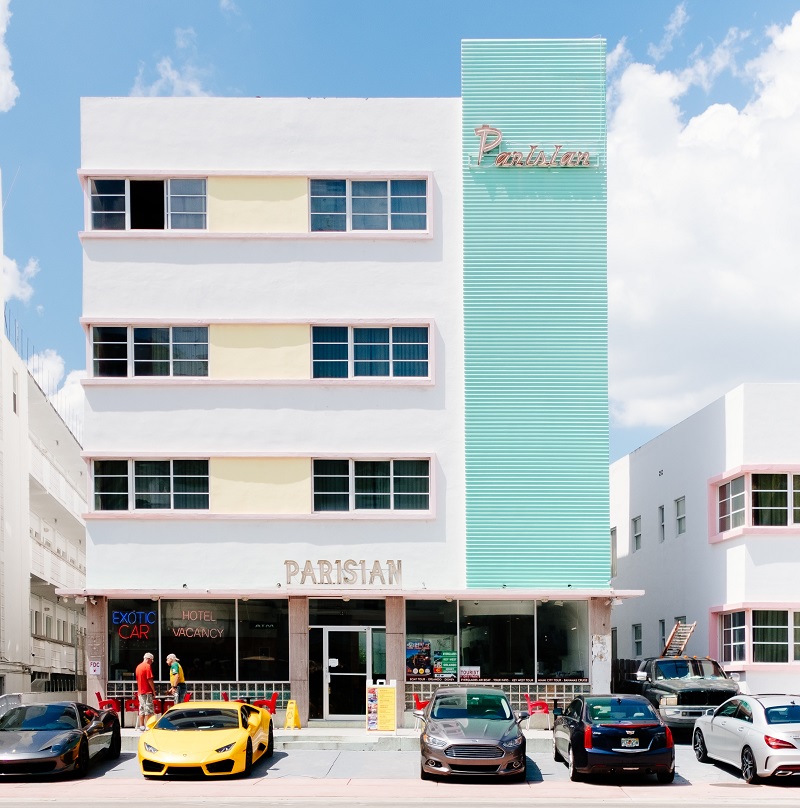
Miami Beach was established in 1913, when a bridge was completed between Miami and the beaches to the east. The lovely area attracted people from the beginning, and a rapid expansion took place. The city grew blissfully in the era when art deco was the dominant architectural style, and Miami Beach’s high sun and soft sand developed the place’s own variation of the style.
Today, you can see countless examples of the distinctive and beautiful style that was built mainly on the streets from 5th Street to 15th Street, and the period started in 1930 with the Bass Museum of Art and two hotels and ended with World War II.
You can best get a feel for the unique neighborhood by taking your time for a walk, where you let the impressions, shapes and colors come to you. Along the way you can see many well-known buildings such as Beacon (1936), Waldorf Towers (1937) and Breakwater (1939) on Ocean Drive, Tiffany (1939), St. Moritz (1939), National (1940) and Delano (1947) on Collins Avenue and Plymouth (1940) on 21st Street.
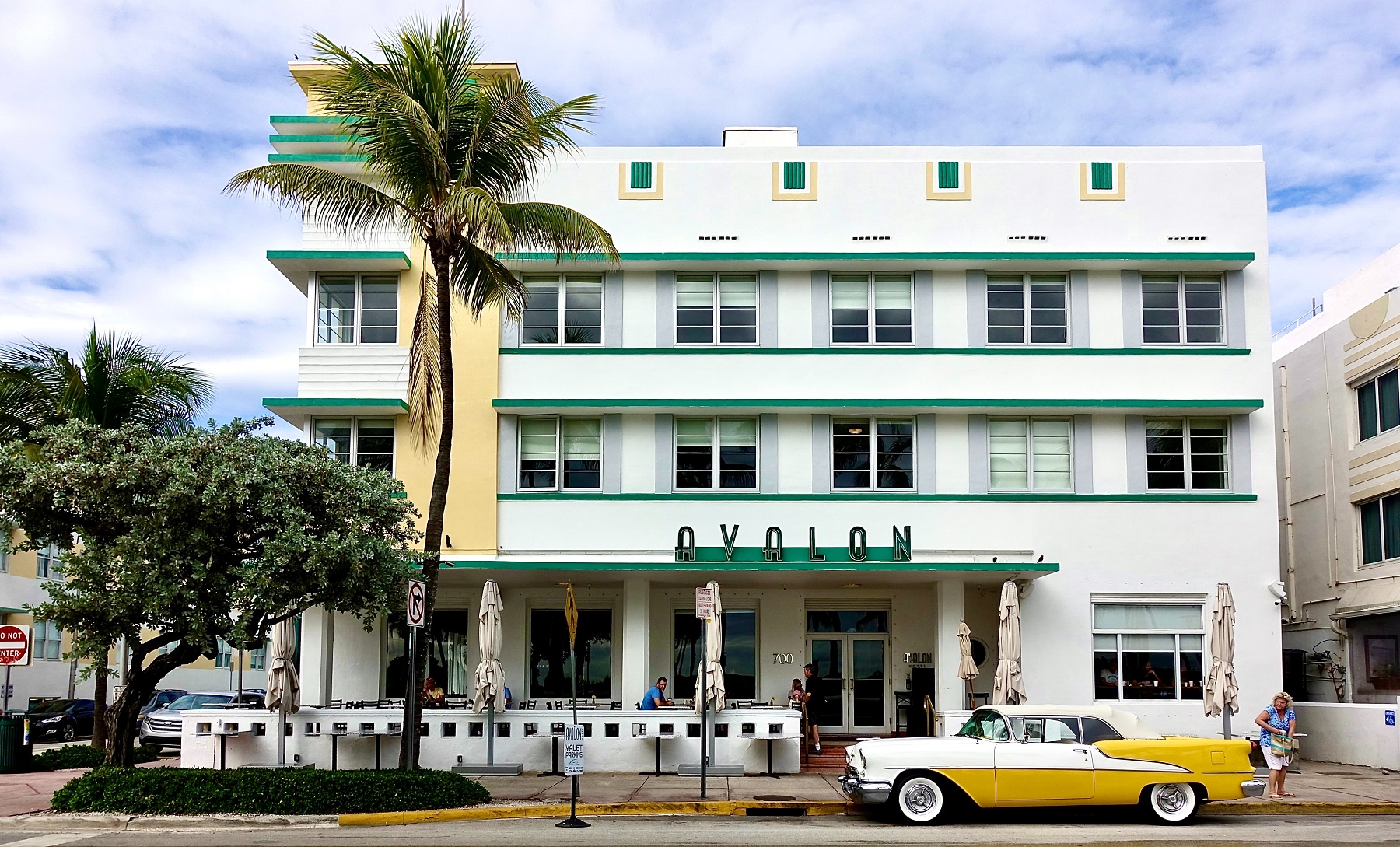
Ocean Drive is probably the most famous street in Miami Beach, and it is well visited with its beach and attractions. With the many art deco hotels and buildings, Ocean Drive has also become one of the landmarks of the Miami area. The street is the center of the district’s outdoor life with cafes, bars and restaurants between palm trees and the beautiful art deco houses in pastel colours.
You can of course enjoy the beach along Ocean Drive, and between dips in the waves it is a good idea to take a closer look at the street’s iconic art deco buildings, which include The Carlyle (1250 Ocean Drive), which was designed by Richard Kiehnel and opened in 1939. The Carlyle has been the setting for many film productions such as Scarface, The Birdcage and Random Hearts.
The house The McAlpin (1430 Ocean Drive) from 1940 is almost the epitome of Miami Beach’s art deco with symmetrical lines and shades of pink and turquoise. You can also see The Colony Hotel (736 Ocean Drive), designed by Henry Hohauser in 1935. The style of The Colony Hotel was Miami Beach’s first use of streamline moderne, which was an aerodynamic variant of Art Deco.

Downtown Miami is the center and business district of the American metropolis. Flagler Street is Miami’s main street, and the concentration of the city’s skyscrapers from primarily the 1970s and 1980s makes a great streetscape. The high-rises are side by side at up to 55 storeys. In the evening, the buildings are beautifully illuminated.
There are many unique attractions in and around downtown Miami. You can of course visit them, but you can also take a stroll along not least Flagler Street, NE 1st Street and other of the area’s central streets. Here are a number of buildings in Miami’s historic district.
The whole cityscape is interesting, but you can notice special buildings like the Olympia Theater (174 E Flagler Street), which opened in 1926 as an atmospheric movie theater and vaudeville stage. The theater, along with the neighboring building, were the first to be built with air conditioning in Miami.
Directly across from the Olympia Theater is the Alfred I. Dupont Building (169 E Flagler Street), which opened in 1939 as Miami’s only Art Deco skyscraper. On the opposite street corner of the skyscraper (200 E Flagler Street) is the old Walgreens superstore, which was built in streamline moderne in 1936.
At the intersection of Flagler Street and Miami Avenue you can see Burdines’ old department store, which opened here in the early 1900s. In the 1930s, the department store was rebuilt in the international steamline moderne style of the time, which can still be seen today.
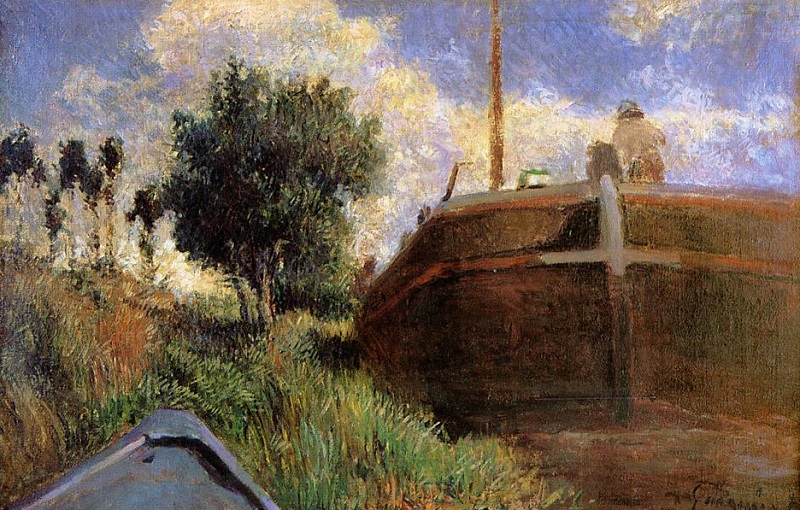
Lowe Art Museum is an art museum with a wide collection. From America, here are several works from the cultures of the Mayans and the Incas, as well as from Indians in the USA. The Seminole and Navajo Indian tribes are among those represented, as are 19th century artists and modern American art.
The museum at the University of Miami also houses an art collection that displays finds from ancient Greece and Rome, European art from the Baroque, Renaissance and up to the 19th century. You can see a lot of other art from, for example, European masters as well. You can thereby experience a very broad art collection with something for every taste and interest.
Bayside Marketplace is an open-air shopping center on the Port of Miami. The center’s palm trees, boats and relaxed atmosphere give it a real Miami feel. Among the shops in the shopping center there is a lively atmosphere with local artists and performers, restaurants with both American and Cuban food and access to the many tour boats that sail the area. You can also take a walk in the adjacent Bayfront Park.
From Bayside Marketplace you can sail on trips to the islands of the Miami area, and the tour of the harbor and the tour around the most luxuriously landscaped islands are recommended. The cruise is like revisiting the TV series Miami Vice from the 1980s, and you see both Miami’s impressive facilities for cruise ships and the lavish homes of the celebrities, which are located in Miami and on Miami Beach. Al Capone, Julio Iglesias and Gloria Estefan are just a few of those who have lived in the area over time, which includes islands such as Hibiscus Island, Star Island and the Venetian Islands.

The Miami-Dade County Courthouse is a high-rise building that was built as Miami’s City Hall and Dade County’s courthouse and jail in the years 1925-1928. With a height of 110 meters, the building was the tallest in both Miami and the state of Florida. Today, the high-rise still functions as a courthouse.
The Miami-Dade County Courthouse has been overtaken by countless modern skyscrapers in height, but the courthouse still stands as one of Miami’s most beautiful high-rises. It was the architect Albert Anthony Ten Eyck Brown who had submitted a proposal for a new city hall in Atlanta. His proposal did not win and he instead offered it to Miami, who approved it.
Arsht Center is a modern cultural center for various performing arts. The large center consists of several buildings and was opened after five years of construction in 2006. In the middle of the modern architecture you can see a preserved art deco tower. It was formerly the main entrance to the Sears department store, which was located on this site for many years and which was entirely built in Art Deco in 1929.
The Archt Center was designed by architect César Pelli and built on both sides of Biscayne Boulevard with a pedestrian bridge between the two parts of the complex. There are three main stages in the centre, The Sanford and Dolores Ziff Ballet Opera House, The John S. and James L. Knight Concert Hall and The Carnival Studio Theater.
Gesu Church is a Roman Catholic church in central Miami. The first church on the site was built in 1896-1897, making it the oldest Catholic church in the city. The first Catholic service in Miami was held in 1872 by Reverend Dufau. The pioneer Wagner family attended the service, and in 1875 William Wagner built a wooden church that became Miami’s first religious house.
It was Henry Flagler who donated a plot of land for the construction of the Gesu Church. After a few years of growth in Miami, the congregation had become too large for the 19th century church, and in 1920-1925 the current Gesu Church was built in a Mediterranean style, which was also used in other constructions in contemporary Miami. The church interior is open and with fine decorations such as the stained-glass windows and the altar.

The Vizcaya Museum and Gardens is a beautiful facility in and around the Vizcaya mansion, which was built in Italian Renaissance style from 1914 to 1923. It was businessman James Deering who built Villa Vizcaya. The architecture was inspired by villas from Tuscany and Veneto in Italy, and the result was a villa in beautiful Mediterranean architecture.
Over the decades, the mansion has hosted summits in the city, and the guest list over time includes Queen Elizabeth II, Pope John Paul II and Ronald Reagan. Today, Miami-Dade County owns the beautiful place, which is open as a museum with access to both the Vizcaya mansion and its surrounding gardens.
Inside the Vizcaya mansion, you can see works of art and fine furniture from all over the world, with an emphasis on European furniture and handicrafts from the 15th-19th centuries. There are several fine houses in the complex, which also includes the casino building, for example. You can also see beautifully decorated rooms in the house and of course enjoy a walk in the subtropical park with a beautiful view of Biscayne Bay.
The Miami Tower is a skyscraper that was constructed as the CenTrust Tower in 1987 by CenTrust Bank. It was the architectural firm Pei Cobb Freed & Partners who designed the high-rise, which has 47 floors and a height of 191 meters. As a special detail, a MetroMover station was built into the high-rise, the first of its kind in the world.
Today, the Miami Tower is one of many skyscrapers in downtown Miami, and although it is not one of the tallest, the high-rise is one of the most distinctive with its three-part glass facade. It can be seen even more clearly in the evening, when the whole facade lights up in different colors and on the occasion of different events.
Pérez Art Museum Miami nicknamed PAMM is a museum of contemporary art. The museum was founded in 1984 and for several years was known as the Miami Art Museum before it got its current name. The current museum building was designed by the Swiss architects Herzog and de Meuron and erected in Museum Park from 2010.
PAMM has expanded its art collection since 1996, and there are many interesting works in the museum’s exhibitions today. The focus of the collections is on art from the 20th century to the present day from African, American and European artists who are geographically as close to the Atlantic Ocean as Miami. You can see works by, among others, Olafur Eliasson, Diego Rivera and José Bedia Valdés. There is art in the museum building and in the park around the museum.
The mid-19th century was a time when new settlers came to the Miami area, including William Wagner and his Creole wife Everline. Wagner was sent to Fort Dallas along the Miami River after military service elsewhere. He built the wooden house around 1855-1857, today called the William Wagner House, as the family home.
The William Wagner House was originally located on a tributary of the Miami River, but it was moved with the growth of Miami and the expansion of the central areas. The house is the only one that has been preserved from its time, thereby giving a unique impression of the settlements around the Miami River in the city’s early days. William Wagner lived in the house until his death in 1901.
The Museum of Contemporary Art is a museum that opened as a gallery with changing exhibitions in 1982. In 1995, the institution established its own collection, and the following year the museum opened in the current museum building. The museum is also known as MOCA.
Today, you can see several hundred works by both established and new contemporary artists in MOCA’s permanent exhibition. Among others, you can see works by Pablo Cano, Teresita Fernandez, Keith Haring, Alex Katz, Edward Ruscha and George Segal.
The Bass Museum of Art is an art museum that was established in 1963 when the city of Miami Beach got a donation of the art collection of John and Johanna Bass. The museum opened the following year, and since then you have been able to see European art from the 15th century to the present day at the museum. In the museum’s collection, there are several works from the entire American area as well.
The Bass Museum of Art opened in a beautiful Art Deco building that was constructed 1930-1934 as the Miami Beach Public Library and an art gallery. It was Russell Pancoast who designed the distinctive building, which, with its limestone facade, has a different expression than the later Art Deco hotels for which Miami Beach is famous.
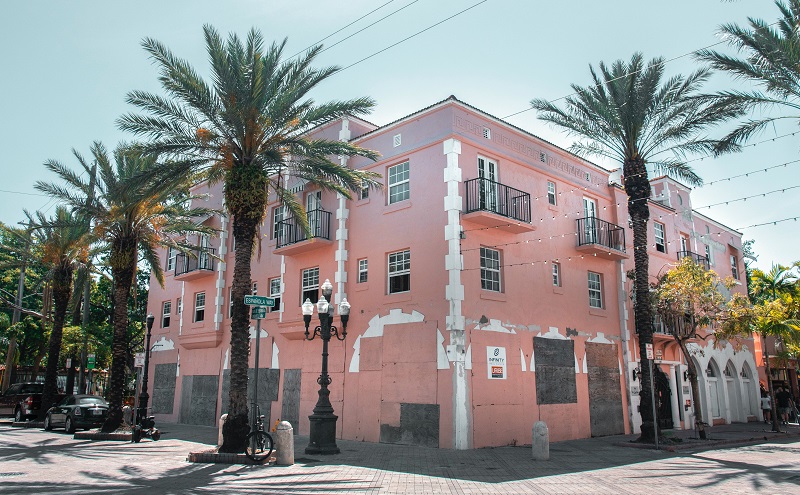
Little Havana is the neighborhood where a large number of Cuban immigrants have settled in Miami over the years. Later, other peoples from South and Central America also settled in Little Havana, and on a visit to the district you can therefore experience a lovely atmosphere that is a mixture of Caribbean and South American culture.
Little Havana’s main street is called Calle Ocho, which means Eighth Street. The street is the center of the neighborhood’s annual festival in March, and on a daily basis you can buy exotic goods here and not least eat some tasty Caribbean food.
You can also go for a walk and enjoy the relaxed atmosphere of Maximo Gomez Park. Here you can see Cubans over a game of chess, and next to the park is Paseo de las Estrellas, which is the South American version of Hollywood’s Walk of Fame.
Royal Palm Cottage is a log house that stands as one of approximately 30 houses of this type that Henry Flagler built in the area in 1897. The Victorian houses were built for people who worked at Flagler’s Royal Palm Hotel. The houses were painted in a color called Flagler Yellow because it was Henry Flagler’s favorite color.
Flagler’s houses were later rented out for between $15 and $22 a month, but over time people moved out and they were torn down until only the Royal Palm Cottage remained. The house was moved to its current location in 1979 to preserve what stands as an example of an era in the development of Miami.

Freedom Tower is one of the most distinctive high-rise buildings in downtown Miami. It was built as the headquarters of The Miami News newspaper in 1925 in a Mediterranean architecture inspired by the Giralda bell tower of the cathedral in Seville, Spain. At the time of its construction, the tower building was one of the tallest structures in Miami, but today the Freedom Tower stands in contrast to downtown’s many modern skyscrapers.
In the years following the Cuban Revolution that brought Fidel Castro to power in Havana in 1959, the building became home to much of the federal aid to the many Cubans who chose to leave Cuba for nearby Florida. Their documents were processed here, and here the Cubans could get medical and dental care. Today, there is a museum in the Freedom Tower, where you can also see the New World Mural 1513.
HistoryMiami is a museum located in downtown Miami. It was established in 1940 as the South Florida Historical Museum. Since 1984, it has been located in the Miami-Dade Cultural Center, where you can enjoy some interesting permanent exhibitions.
There are several themes at the museum, where you can explore the development of life and culture in South Florida, including the indigenous population, the Spanish colonization and many other aspects. There are many other exhibits at the HistoryMiami Museum, where you can see various objects and stories related to Miami’s development.
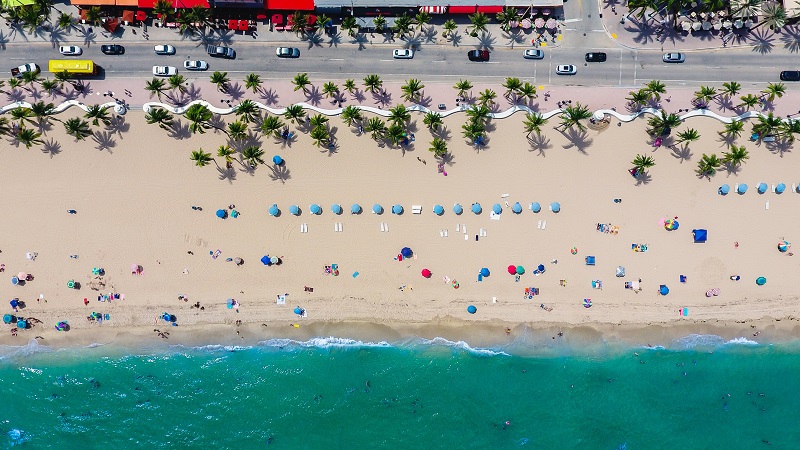
Fort Lauderdale is a city with many canals, islands and sandy beaches, and that makes it a pure holiday paradise and a classy example of fashionable and modern Florida.
In the Riverwalk Arts and Entertainment District, there are a number of shopping centres, restaurants, cafes, cultural institutions (such as the city’s opera house), entertainment (e.g. an IMAX cinema) and some interesting museums such as the Museum of Discovery & Science and the Museum of Art.
Coral Castle is a unique house that Ed Leedskalnin spent 28 years building by himself. Ed was born in Riga in 1887, and the day before he was to marry the love of his life, Agnes, she called off the wedding. Since that time, Ed wanted to build a memorial to Agnes and Coral Castle was the result.
Coral Castle was built from 1,100 tons of stone, all of which Ed Leedskalnin cut out using only hand tools in the years 1923-1951. Coral Castle is surrounded by a ring wall, and therefore looks like a castle from the outside. Behind the wall, in addition to the Coral Castle house, you can see some of Ed Leedskalnin’s works of art in stone.
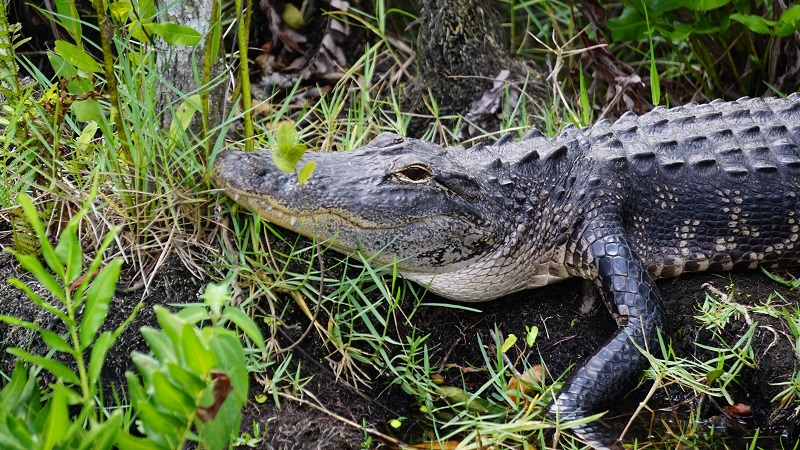
Everglades National Park is one of the largest national parks in USA. You can explore the large swamp and mangrove areas that once covered the whole of southern Florida. Nature is vast, and the view is good when you get just a few meters above ground.
The climate in the national park is subtropical, and you can see many different plants such as swamp grass, cypresses and pine trees. The park’s birdlife is particularly rich, and the Everglades is known for its many alligators, which live side by side with the far fewer American crocodiles.
You can drive around Everglades National Park yourself or go to the area on an organized tour. You can also try a trip with the propeller-driven airboats that float on the surface of the water. It’s a special Everglades experience.
The Everglades Alligator Farm is a combination of a farm and a zoo. Located just outside of Everglades National Park, the farm is home to approximately 2,000 alligators of all sizes. Here are also specimens of the rarer American crocodile, which the farms have helped to save from extinction.
There are several alligator farms located near Everglades National Park. Everglades Alligator Farm is one of the farms, while Everglades Safari Park (26700 Tamiami Trail) is another to visit.
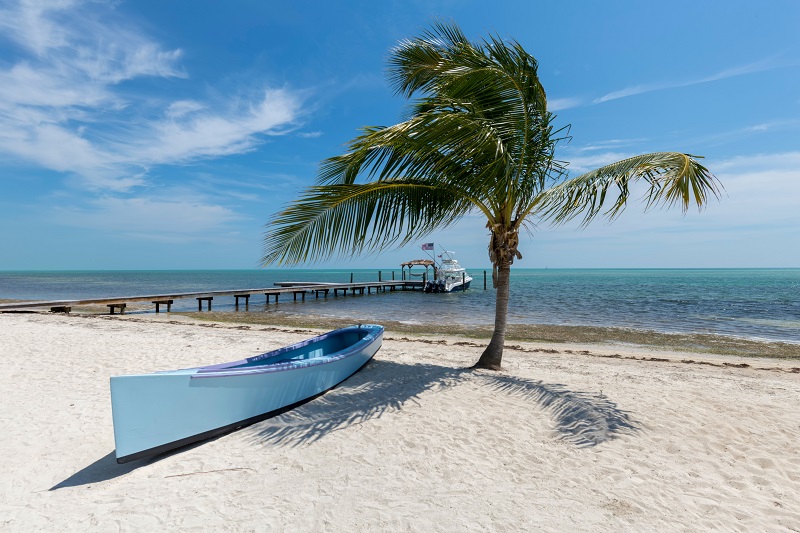
The Florida Keys is a beautiful string of tropical islands that connects the area south of Miami with Key West in the Gulf of Mexico. The islands are connected by roads, bridges and dams, and all along the main road to the city of Key West to the west there are cozy beaches, small lagoons, lovely places to eat and many possible activities on land and in the warm water.
About halfway towards Key West is Marathon, where the beautiful Coco Plum Beach is located. Here you can take a dip in beautiful surroundings. In Marathon there is also a dolphin center that you can visit.
Along the road to Key West you can also see remains of Henry Flagler’s railroad from Miami to Key West. It was opened in 1912, but closed already in 1935 due to a tropical storm that destroyed large parts of the railroad line, not least many bridges were destroyed. The railroad was sold to the state of Florida, which later built the Overseas Highway to Key West on top of much of Flagler’s old railroad.

Key West is the southernmost city in the continental USA, and it is only 145 km between Key West and the island of Cuba. The Old Town of Key West is worth seeing and a relaxing place for a stroll. In the evening, many gather at Mallory Square to watch the city’s famous sunset.
Among the city’s famous residents was Nobel laureate Ernest Hemingway, whose house is now a museum (907 Whitehead Street). Hemingway lived here more than ten years, where he also wrote some of his works.
In the Truman Little White House (111 Front Street) you get an insight into a part of US presidential history, as Harry Truman, Dwight D. Eisenhower, John F. Kennedy and Jimmy Carter have been here on various occasions. Harry Truman ruled the USA from here for 175 days during his presidency, which is why the house is also called the Little White House. The house was built in 1890, and during the First World War Thomas Edison lived here.
You should also visit the Audubon House (205 Whitehead Street), which is furnished as in 19th century Key West. The house is beautifully located in a tropical garden, and it gives a good impression of the historical atmosphere of the city. Most tourists in the city also swing past the southern end of South Street, where you can see the marker that Key West is the southernmost point in the continental United States.

Henry Flagler was the man who initiated the development of the Miami area by extending his railroad from West Palm Beach to Miami. He is considered the founder of modern Miami. Flagler was a railroad magnate and, along with John D. Rockefeller and Samuel Andrews, he was one of the founders of Standard Oil.
The Flagler Museum in the city of Palm Beach tells the story of the man and his railroad. The museum is housed in Whitehall, a beautiful mansion built by Henry Flagler in 1902 in the Beaux Arts style.
In addition to Whitehall, Henry Flagler’s private railroad car can be seen parked in the backyard. Car No. 91 was purpose-built in 1886 and is now restored to its 1912 appearance, when Flagler rode in the car at the opening of The Overseas Railroad connecting Miami and Key West. Completing the course over the Florida Keys was an engineering marvel of its time.
19501 Biscayne Boulevard
aventuramall.com
Biscayne Boulevard
baysidemarketplace.com
7535 North Kendall Drive
simon.com
11401 NW 12th Street
shopdolphinmall.com
12801 West Sunrise Boulevard
simon.com/sawgrass-mills
Between Biscayne Boulevard and 3rd Avenue, between NE 36th and 41st, Lincoln Road Mall
Everglades Alligator Farm
40351 SW 192nd Ave, Homestead
everglades.com
Miami Metrozoo
12400 Southwest 152nd Street
miamimetrozoo.com
Miami Seaquarium
4400 Rickenbacker Causeway
miamiseaquarium.com
Monkey Jungle
14805 Southwest 216th Street
monkeyjungle.com
Parrot Jungle
1111 Parrot Jungle Trail
parrotjungle.com
Miami and southern Florida have been inhabited by Native Americans for about 10,000 years. It was supposed to go to about 1500, when Juan Ponce de León unsuccessfully tried to colonize the area. In 1567, the Spaniards built a mission church at the mouth of the Miami River and a fortress on the same site in 1743. It became the start of a major immigration.
The Seminole Indians were in the area, and through primarily the 19th century came many meetings. Three wars between the settlers and the Seminole Indians were waged. The Second Seminole War, which ended in 1842, was extremely bloody and wiped out large sections of the population of southeast Florida. The second and last war was in the period 1855-1858, and after a few decades there were not many Indians still living in the area.
In the 19th century, there were scattered buildings with some plantations around present-day Miami. Julia Tuttle, a Cleveland farmer, bought a large citrus orchard in 1891 and, in addition to farming, wanted to stimulate growth in the area. To do this, she contacted railroad magnate Henry Flagler and sought to have him extend his course in East Florida.
Only after three years was Flagler persuaded. And in 1896, Miami was founded with 344 residents. Not least, the railroad helped the lush area to easily attract many immigrants. In 1900, 1,700 people lived here, 10 years later the population was 5,500 and by 1920 the number had increased to 29,000.
In the early 1920s, Miami’s development exploded. The handling of the Prohibition period was very liberal and games were allowed, which resulted in many migrants from the northern United States. The city saw a real construction boom and the first skyscrapers were erected.
In 1926, prosperous times abruptly stopped with the great hurricane that hit the coast just south of Miami. Virtually no buildings survived the storm during the partial or total destruction. After the hurricane, the city took some sort of advance on the depression that hit the country from 1929 due to economic recession.
In the 1930s, Miami Beach was expanded in a very short space of time, creating the unique Art Deco neighborhood, which has become one of the city’s largest and most popular attractions. During World War II, the United States erected large military facilities in Miami, contributing to the fact that about 500,000 people lived here in 1950.
The city continued to grow, and after Fidel Castro’s Cuban revolution in 1959, many arrived in Miami, in 1965 alone more than 100,000. They founded the Little Havana district and are at the heart of the large Hispanic population.
In the 1980s, the foundation of all of modern Miami and contemporary tourism was laid. A lot of money poured into the city, and apartment complexes, luxury villas, five-star hotels and nightclubs popped up everywhere. Miami Vice was a popular TV series in many countries and it helped to promote Miami.

Overview of Miami
A trip to Miami is a trip to Florida’s lovely climate, the Art Deco neighborhood of the beaches, countless activities and theme parks, more than a million alligators, tropical beaches and much more. You will never get bored in Florida, and this is especially true in the Florida city.
The Art Deco neighborhood of Miami Beach is very special with the local variation of the 1930s style of construction. Pastel colors, typical patterns and a special radiance are distinctive features, and the houses from that time stand along the famous promenade, Ocean Drive, and in many other streets and neighborhoods located on the beaches east of the city of Miami.
About the upcoming Miami travel guide
About the travel guide
The Miami travel guide gives you an overview of the sights and activities of the American city. Read about top sights and other sights, and get a tour guide with tour suggestions and detailed descriptions of all the city’s most important churches, monuments, mansions, museums, etc.
Miami is waiting for you, and at vamados.com you can also find cheap flights and great deals on hotels for your trip. You just select your travel dates and then you get flight and accommodation suggestions in and around the city.
Read more about Miami and the USA
Buy the travel guide
Click the “Add to Cart” button to purchase the travel guide. After that you will come to the payment, where you enter the purchase and payment information. Upon payment of the travel guide, you will immediately receive a receipt with a link to download your purchase. You can download the travel guide immediately or use the download link in the email later.
Use the travel guide
When you buy the travel guide to Miami you get the book online so you can have it on your phone, tablet or computer – and of course you can choose to print it. Use the maps and tour suggestions and you will have a good and content-rich journey.
Art Deco • Ocean Drive • Little Havana • Downtown • Miami Beach

Overview of Miami
A trip to Miami is a trip to Florida’s lovely climate, the Art Deco neighborhood of the beaches, countless activities and theme parks, more than a million alligators, tropical beaches and much more. You will never get bored in Florida, and this is especially true in the Florida city.
The Art Deco neighborhood of Miami Beach is very special with the local variation of the 1930s style of construction. Pastel colors, typical patterns and a special radiance are distinctive features, and the houses from that time stand along the famous promenade, Ocean Drive, and in many other streets and neighborhoods located on the beaches east of the city of Miami.
About the upcoming Miami travel guide
About the travel guide
The Miami travel guide gives you an overview of the sights and activities of the American city. Read about top sights and other sights, and get a tour guide with tour suggestions and detailed descriptions of all the city’s most important churches, monuments, mansions, museums, etc.
Miami is waiting for you, and at vamados.com you can also find cheap flights and great deals on hotels for your trip. You just select your travel dates and then you get flight and accommodation suggestions in and around the city.
Read more about Miami and the USA
Buy the travel guide
Click the “Add to Cart” button to purchase the travel guide. After that you will come to the payment, where you enter the purchase and payment information. Upon payment of the travel guide, you will immediately receive a receipt with a link to download your purchase. You can download the travel guide immediately or use the download link in the email later.
Use the travel guide
When you buy the travel guide to Miami you get the book online so you can have it on your phone, tablet or computer – and of course you can choose to print it. Use the maps and tour suggestions and you will have a good and content-rich journey.

The Miami-Dade County Courthouse is a high-rise building that was built as Miami’s City Hall and Dade County’s courthouse and jail in the years 1925-1928. With a height of 110 meters, the building was the tallest in both Miami and the state of Florida. Today, the high-rise still functions as a courthouse.
The Miami-Dade County Courthouse has been overtaken by countless modern skyscrapers in height, but the courthouse still stands as one of Miami’s most beautiful high-rises. It was the architect Albert Anthony Ten Eyck Brown who had submitted a proposal for a new city hall in Atlanta. His proposal did not win and he instead offered it to Miami, who approved it.
Arsht Center is a modern cultural center for various performing arts. The large center consists of several buildings and was opened after five years of construction in 2006. In the middle of the modern architecture you can see a preserved art deco tower. It was formerly the main entrance to the Sears department store, which was located on this site for many years and which was entirely built in Art Deco in 1929.
The Archt Center was designed by architect César Pelli and built on both sides of Biscayne Boulevard with a pedestrian bridge between the two parts of the complex. There are three main stages in the centre, The Sanford and Dolores Ziff Ballet Opera House, The John S. and James L. Knight Concert Hall and The Carnival Studio Theater.
Gesu Church is a Roman Catholic church in central Miami. The first church on the site was built in 1896-1897, making it the oldest Catholic church in the city. The first Catholic service in Miami was held in 1872 by Reverend Dufau. The pioneer Wagner family attended the service, and in 1875 William Wagner built a wooden church that became Miami’s first religious house.
It was Henry Flagler who donated a plot of land for the construction of the Gesu Church. After a few years of growth in Miami, the congregation had become too large for the 19th century church, and in 1920-1925 the current Gesu Church was built in a Mediterranean style, which was also used in other constructions in contemporary Miami. The church interior is open and with fine decorations such as the stained-glass windows and the altar.

The Vizcaya Museum and Gardens is a beautiful facility in and around the Vizcaya mansion, which was built in Italian Renaissance style from 1914 to 1923. It was businessman James Deering who built Villa Vizcaya. The architecture was inspired by villas from Tuscany and Veneto in Italy, and the result was a villa in beautiful Mediterranean architecture.
Over the decades, the mansion has hosted summits in the city, and the guest list over time includes Queen Elizabeth II, Pope John Paul II and Ronald Reagan. Today, Miami-Dade County owns the beautiful place, which is open as a museum with access to both the Vizcaya mansion and its surrounding gardens.
Inside the Vizcaya mansion, you can see works of art and fine furniture from all over the world, with an emphasis on European furniture and handicrafts from the 15th-19th centuries. There are several fine houses in the complex, which also includes the casino building, for example. You can also see beautifully decorated rooms in the house and of course enjoy a walk in the subtropical park with a beautiful view of Biscayne Bay.
The Miami Tower is a skyscraper that was constructed as the CenTrust Tower in 1987 by CenTrust Bank. It was the architectural firm Pei Cobb Freed & Partners who designed the high-rise, which has 47 floors and a height of 191 meters. As a special detail, a MetroMover station was built into the high-rise, the first of its kind in the world.
Today, the Miami Tower is one of many skyscrapers in downtown Miami, and although it is not one of the tallest, the high-rise is one of the most distinctive with its three-part glass facade. It can be seen even more clearly in the evening, when the whole facade lights up in different colors and on the occasion of different events.
Pérez Art Museum Miami nicknamed PAMM is a museum of contemporary art. The museum was founded in 1984 and for several years was known as the Miami Art Museum before it got its current name. The current museum building was designed by the Swiss architects Herzog and de Meuron and erected in Museum Park from 2010.
PAMM has expanded its art collection since 1996, and there are many interesting works in the museum’s exhibitions today. The focus of the collections is on art from the 20th century to the present day from African, American and European artists who are geographically as close to the Atlantic Ocean as Miami. You can see works by, among others, Olafur Eliasson, Diego Rivera and José Bedia Valdés. There is art in the museum building and in the park around the museum.
The mid-19th century was a time when new settlers came to the Miami area, including William Wagner and his Creole wife Everline. Wagner was sent to Fort Dallas along the Miami River after military service elsewhere. He built the wooden house around 1855-1857, today called the William Wagner House, as the family home.
The William Wagner House was originally located on a tributary of the Miami River, but it was moved with the growth of Miami and the expansion of the central areas. The house is the only one that has been preserved from its time, thereby giving a unique impression of the settlements around the Miami River in the city’s early days. William Wagner lived in the house until his death in 1901.
The Museum of Contemporary Art is a museum that opened as a gallery with changing exhibitions in 1982. In 1995, the institution established its own collection, and the following year the museum opened in the current museum building. The museum is also known as MOCA.
Today, you can see several hundred works by both established and new contemporary artists in MOCA’s permanent exhibition. Among others, you can see works by Pablo Cano, Teresita Fernandez, Keith Haring, Alex Katz, Edward Ruscha and George Segal.
The Bass Museum of Art is an art museum that was established in 1963 when the city of Miami Beach got a donation of the art collection of John and Johanna Bass. The museum opened the following year, and since then you have been able to see European art from the 15th century to the present day at the museum. In the museum’s collection, there are several works from the entire American area as well.
The Bass Museum of Art opened in a beautiful Art Deco building that was constructed 1930-1934 as the Miami Beach Public Library and an art gallery. It was Russell Pancoast who designed the distinctive building, which, with its limestone facade, has a different expression than the later Art Deco hotels for which Miami Beach is famous.

Little Havana is the neighborhood where a large number of Cuban immigrants have settled in Miami over the years. Later, other peoples from South and Central America also settled in Little Havana, and on a visit to the district you can therefore experience a lovely atmosphere that is a mixture of Caribbean and South American culture.
Little Havana’s main street is called Calle Ocho, which means Eighth Street. The street is the center of the neighborhood’s annual festival in March, and on a daily basis you can buy exotic goods here and not least eat some tasty Caribbean food.
You can also go for a walk and enjoy the relaxed atmosphere of Maximo Gomez Park. Here you can see Cubans over a game of chess, and next to the park is Paseo de las Estrellas, which is the South American version of Hollywood’s Walk of Fame.
Royal Palm Cottage is a log house that stands as one of approximately 30 houses of this type that Henry Flagler built in the area in 1897. The Victorian houses were built for people who worked at Flagler’s Royal Palm Hotel. The houses were painted in a color called Flagler Yellow because it was Henry Flagler’s favorite color.
Flagler’s houses were later rented out for between $15 and $22 a month, but over time people moved out and they were torn down until only the Royal Palm Cottage remained. The house was moved to its current location in 1979 to preserve what stands as an example of an era in the development of Miami.

Freedom Tower is one of the most distinctive high-rise buildings in downtown Miami. It was built as the headquarters of The Miami News newspaper in 1925 in a Mediterranean architecture inspired by the Giralda bell tower of the cathedral in Seville, Spain. At the time of its construction, the tower building was one of the tallest structures in Miami, but today the Freedom Tower stands in contrast to downtown’s many modern skyscrapers.
In the years following the Cuban Revolution that brought Fidel Castro to power in Havana in 1959, the building became home to much of the federal aid to the many Cubans who chose to leave Cuba for nearby Florida. Their documents were processed here, and here the Cubans could get medical and dental care. Today, there is a museum in the Freedom Tower, where you can also see the New World Mural 1513.
HistoryMiami is a museum located in downtown Miami. It was established in 1940 as the South Florida Historical Museum. Since 1984, it has been located in the Miami-Dade Cultural Center, where you can enjoy some interesting permanent exhibitions.
There are several themes at the museum, where you can explore the development of life and culture in South Florida, including the indigenous population, the Spanish colonization and many other aspects. There are many other exhibits at the HistoryMiami Museum, where you can see various objects and stories related to Miami’s development.
Similar to Miami Travel Guide